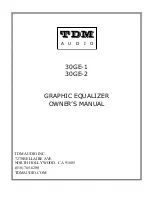
© 2003 TDM Audio, Inc.
Graphic Equalizer Owner’s Manual
Page 5
Fundamentals
n equalizer is used to alter the balance of frequencies in an audio signal. In some cases this
is done to compensate for the poor acoustic characteristics of a room or the inaccurate
frequency response of a speaker system. In other cases it is done to change the characteristic
sound of a particular signal source such as a voice or a musical instrument. TDM 30GE series
equalizers can be used for either purpose.
There are several different kinds of equalizers, but they all use
filters
to change the frequency
balance of an audio signal. Filters let the operator reduce or increase the levels of certain ranges
of frequencies in the signal. TDM 30GE series equalizers are
graphic
equalizers. Graphic
equalizers provide a series of sliders, one for each range of frequencies that the equalizer can
influence. They are called graphic equalizers because the sliders form a graph of the frequency
response of the equalizer.
Why Equalizers are Needed
Speaker systems and acoustic environments interact in complex ways. The result is that a
particular audio system in a particular room or environment will usually have less-than-ideal
frequency response characteristics. Speaker system designers do their best to manage the
tradeoffs involved and produce the best products they can for a particular purpose, but no
speaker system is ideal in all environments and situations. Many factors beyond the control of
speaker designers and audio engineers influence audio system performance. These factors can
include ambient temperature, air movement, and the number of people in an area. Additionally,
some rooms just have poor acoustics because of other practical considerations. Acoustics are
often not the first consideration when designing a space that will accommodate spectator events
(consider a high-school gymnasium for example). Because all of these factors beyond our
control can change the frequency characteristics of audio systems in undesirable ways, we use
equalizers to compensate—to try to adjust the signal electronically, to “equalize” its frequencies.
Equalizers are also used to adjust the frequency balance of a particular signal such as an
instrument or voice, either to compensate for some problem or to achieve a particular effect. For
example, an acoustic guitar with a pickup will produce a signal that is not generally an accurate
representation of how the guitar sounds acoustically. An equalizer might be used to make the
signal sound more natural. Perhaps an electric bass player likes a sound with a lot of presence
and attack. Many electric basses do not naturally have this kind of sound so an equalizer might
be used to achieve this effect.
There are a lot of applications for equalizers, but they all involve changing the balance of
frequencies in a signal so that it
sounds better
. It is important to remember when setting up
electronic audio equipment that the goal is to achieve good sound. Sometimes a good sanity
check is to bypass the equalizer at some point during the sound check (don’t do this during a live
event!) and compare the sound. If it doesn’t sound better with the equalizer
in
then you are not
getting any benefit from equalization. Be aware that if you bypass the equalizer where you have
a lot of frequencies cut, the sound will get a lot louder so be prepared for this.
A



































